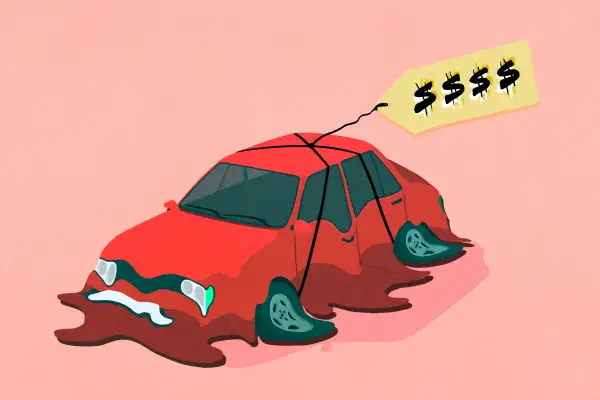I Almost Panic-Bought a Car to Avoid Trump's Tariffs. Here’s Why I’m Glad I Didn’t

Two years ago, I ditched my paid-off 2015 Ford Focus for a cherry-red moped, like any normal person would. I wanted to cut my expenses drastically, and trading four wheels for two just made sense for my lifestyle. Since then, I’ve saved more than $4,000 a year.
But when the Trump administration rolled out its auto tariff plan in late March, doubt washed over me. I began second-guessing my decision, worrying that not having a car now would cost me more later. I wasn't alone, either: Americans have been rushing to buy cars ahead of the 25% levies on imported vehicles, which are expected to push car prices even higher.
Spooked, I nearly jumped on the bandwagon — especially after seeing some car dealerships promoting so-called "tariff sales". But then I tapped into the part of my brain that writes about personal finance for a living. Rationally, I know that making a big-ticket purchase in a volatile rate and trade environment can have costly consequences.
Buying a car out of fear isn't like grabbing an extra pack of toilet paper before prices rise. One sets you back $20 (if you get a multi-pack); the other can derail your finances for years.
“When things are uncertain, the more you have in the way of buffers — such as money in the bank and an emergency fund — the better,” says Rita McGrath, C-suite strategist and professor at Columbia Business School.
With so much uncertainty, I knew I needed to do some research. Here's what I learned.
Tariffs will ‘radically change’ car prices soon
The Trump administration’s 25% tariffs on imported cars and parts could “radically change” car prices in the U.S. over the next few months.
The White House argues that the tariffs will boost domestic manufacturing. However, consumers will likely bear the cost because most cars made in the U.S. have parts produced in other countries. As a result, prices for new vehicles could rise by as much as $12,000, according to Anderson Economic Group.
Most automakers say they will hold their manufacturer's suggested retail price, or MSRP, for now. But some brands could begin adjusting prices as early as this month, as one analyst told PBS News.
Even though prices aren't changing overnight, I realized I'd have to act more quickly than I'm comfortable with to snag the savings I want (which, of course, is what started this whole debacle in the first place).
High demand is making it trickier to negotiate
The car market has remained a seller’s game in recent years, fueled by pandemic-era supply chain disruptions, chip shortages and persistently high demand. That means buyers have less bargaining power, particularly with high-demand models like hybrids and electric vehicles (EVs), according to Curt Hopkins, chief executive officer at MCQ Markets, a rare-car investment platform.
The average price for a new car is nearly $50,000, and dealers are holding firm on pricing because they don’t need to discount inventory when demand outpaces supply like this, Hopkins says. Prices for some of the fastest-selling cars in the U.S., including those from brands like Toyota, Honda, Hyundai and Subaru, will be even tougher to negotiate due to their popularity.
“It's unlikely that trend will change meaningfully in the next couple of quarters unless we see a major macroeconomic shift,” Hopkins says. "If you have flexibility, waiting out this period of uncertainty could offer better negotiating power down the line."
Since I'm not in any rush to buy a car, waiting it out might give me a better shot at negotiating a deal down the line.
Auto loan rates remain high
To no one’s surprise, the Federal Reserve held interest rates steady last week for the third consecutive time while waiting to see the impact of the tariffs on the economy. While decisions made by the central bank don’t directly impact auto loan rates, lenders typically base their rates on the benchmark federal funds rate (which currently sits in a range of 4.25% to 4.5%).
However, the loan rate might not be the most important part of the story, according to McGrath. Auto loan rates are also influenced by other factors, including your credit score, type of vehicle, loan term and down payment.
Even though the Fed cut interest rates three times at the end of last year, financing a car is still expensive. Why? Well, the Fed increased rates 11 times from 2022 to 2023, and consumers are still feeling the aftershocks. As of April, the average auto loan on a new car was 7.1%, according to Edmunds.
Add in rising car prices — driven by tariffs and limited inventory — and financing becomes even less attractive. I realized I'd likely be locking myself into a pricier auto loan than I'm used to, and that's not a commitment I'm willing to make right now.
Used car prices are at their highest in years
If you’ve been holding out for a deal on a used car, 2025 might not be your year. Used car prices are at their highest level since 2023, and with inventory remaining scarce, prices are unlikely to drop anytime soon, according to Edmunds.
"Supply has been tight — especially in the used car market — since the pandemic, giving dealers the upper hand," says McGrath.
While Trump’s tariffs don’t directly impact used car sales, they can still ripple through the market. As new car prices rise and production patterns shift, demand for used vehicles could increase, driving prices higher. Last year, roughly 2.5 million Americans bought a used car. As of last month, the average cost of a used car was about $26,000.
I'm not opposed to buying a used car, but with tariffs likely to boost demand and drive up prices, I'd rather sit tight than pay top dollar.
Tariffs could drive up repair costs
The impact of Trump's tariffs extends beyond just new car sales. They could also make car repairs more expensive.
“Many essential car parts, everything from brake pads to electronic sensors, are sourced internationally,” Hopkins says. “A 25% tariff on foreign-made auto parts, like the one currently being floated, would significantly drive up repair costs for consumers.”
So even if I managed to score a good deal on a car itself, I realized I could still feel the pinch at the repair shop when I inevitably need to take it in for a tune-up... which kind of defeats the purpose.
The bottom line
If you're in the market for a new car — like I thought I was — here's my advice: Don't panic-buy. Avoid making a five-figure decision on a whim.
Instead, be strategic. Do your homework, shop around for the best deal and know that patience might be your most powerful financial tool in this market.
As for me, I'll be scooting around town on my moped in the meantime.
More from Money:
Want to Avoid Auto Tariffs? Here's How to Find Out if a Car is Made in America
10 Everyday Items Trump's Tariffs Could Make Pricier
Car Dealerships Are Running 'Tariff Sales' as Shoppers Scramble to Buy
